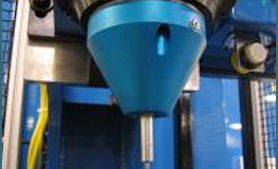径向铆接成型
The radial forming and riveting process is similar to the orbital riveting and forming process, but with radial riveting and forming the material is displaced from the center outward in a rosette or rose curve pattern. The radial riveting process is often the optimal assembly solution when working with small rivet shank diameters, delicate rivet materials, or unsupported rivet assembly applications. Orbitform will help you define the appropriate riveting process, whether radial or orbital.
主要特点
Small Parts
Radial riveting is well suited for rivets with a diameter of 1/8 inch and smaller. In fact the radial forming process was originally developed for watch making applications where tiny rivets are formed.
Delicate Materials
In the radial riveting process the forming peen is driven so no scuffing or galling occurs thus radial riveting is well suited for embossing applications. Also, little side force is applied during the radial riveting process due to displacing of material outwardly from the center.
Flexibility
Exchangeable cartridges allow you to simply convert an Orbitform orbital riveting powerhead into an Orbitform radial riveting powerhead, and vice-versa. This offers you versatility and performance.
Controlled Forming
The radial process allows the rivet to fill "D" type tabs and other irregular sections since material is displaced radially outward. The forming peen is driven so no scuffing or galling occurs thus radial riveting is well suited for embossing applications.
Less Side Force
Less side force is applied during the radial riveting process than with the orbital process due to the displacing of material outwardly from the center using an 11 sided radial pattern. Thus the radial process is ideal for delicate materials.
Process Monitoring
Reduce scrap to increase your throughput and production efficiency.
Click Here to learn more about Orbitform's Process Monitoring for radial riveting and radial forming.




